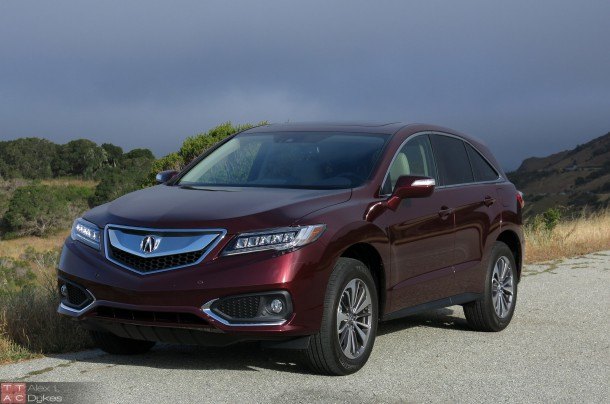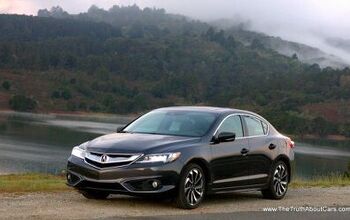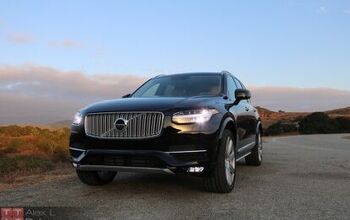2016 Acura RDX AWD Review (With Video)

Acura has been a brand of highs and lows for a while. The MDX has been a perennial best-seller while their large sedans have largely sat unsold. The RDX, meanwhile, has had an interesting history.
Acura’s first attempt at a 2-row crossover was ahead of its time with a 2.3L turbocharged engine producing 240 horsepower and Acura’s Super Handling AWD system capable of sending 90 percent of engine power to the rear. The ride was criticized by Motor Trend as “harsh” and folks complained about turbo lag from the segment’s only four-cylinder turbo engine.
As the segment grew, most entries used naturally aspirated 6-cylinder engines and RDX sales failed to achieve orbit. All indications were that Acura’s compact crossover was destined to be a low-volume niche player in one of the fastest growing segments. Then Acura did something unexpected.
By the 2013 model year, small displacement turbo engines had become a staple in the segment but Acura chose to buck the trend by replacing their 2.3L turbo with a 3.5L V6 during the redesign. The engine swap wasn’t the only thing that surprised Acura fans. Engineers stretched the RDX in every direction, softened the suspension, jacked up the ride height two inches, dialed down the “sport”, removed the SH-AWD system and fitted electric power steering. Proving that the compact luxury crossover shopper isn’t looking for TL Type-S on stilts, RDX sales more than doubled and remain on an upward trajectory, outselling its former BMW nemesis and besting every luxury 2-row crossover save the Lexus RX and Cadillac SRX.
Exterior
Before we go further, we ought to talk about how this crossover segment boils down. In practical terms, there are three different size classes of luxury 2-row crossover. At the top end we have the Cadillac SRX, Lincoln MKX and Lexus RX, which are all 186-200 inches long. Next we have the semi-segment where the RDX plays with the likes of the GLK, MKC, Q5, NX 200t, XC60 and X3. At the small end of the scale lie the Evoque, Q3, GLA and X1. You can consider the RDX a “tweener” in some ways since it’s at the large end of the middle segment but still 6-inches shorter than a Cadillac SRX.
Interior
Spanning from $35,270 to $43,420, the RDX is one of the least expensive vehicles in this segment. As a result, it should not surprise you that you have to step up to the $38,940 model to get leather seats and the 8-way power adjustable passenger seat. As with the rest of the Acura lineup in the USA, real wood trim is unavailable at any price, although we now get standard rear climate vents.
Although the RDX is about the same size as the X3 on the outside, you’ll find four-inches more combined legroom in the Acura, split fairly evenly front and rear, making it easier for drivers with long legs to find an ideal driving position. Unfortunately, some taller drivers will notice the RDX has a little less front headroom than the X3. The trade-off for the roomier digs can be found behind the second row where cargo capacity comes in at 26.1 cubic feet, one cube below the X3, 20% smaller than the XC60 and 45% smaller than the cargo hold in the Lexus RX.
Infotainment
Adding the Technology Package brings the biggest change to the RDX’s interior for 2016: the AcuraLink 2-screen infotainment system. Here’s how Acura has described the split screen rationale: the 8-inch display set high in the dash is used for navigation, leaving the 7-inch touchscreen below to handle climate and audio functions. However, in reality you end up using both screens and their interaction takes some getting used to. While it’s true that you can switch between audio sources with the lower screen while simultaneously watching the navigation map on the upper screen, if you want to browse a playlist, that’s done solely with the upper screen. Entering an address for navigation can be done using either screen with the control wheel/joystick or an on-screen keyboard on the 7-inch screen. The overall design is not as well-integrated as the Infiniti InTouch system in the Q50, but it has grown on me since I first encountered it and the extensive voice command system is one of the best in the segment.
Drivetrain
Early indications were that the RDX would get the same 9-speed ZF automatic transmission as the MDX and TLX. However, for 2016 at least, the RDX continues to use the same Honda/Acura 6-speed automatic as last year. Also the same as last year is an AWD system that’s different from the SH-AWD system in the MDX and TLX. In a nut shell, the MDX can send 90% of engine power to the rear by fully locking the center coupling and over-driving the rear axle vs the front. SH-AWD also has a torque vectoring function which can send 100% of the rear axle power a single rear wheel. The RDX isn’t like that.
To cut weight and cost from the second generation RDX, Acura chose to fit a more conventional AWD system. The current AWD system is somewhat unusual in this segment because the majority of systems will fully lock a center coupling allowing power to be split more or less 50-50 front to rear. The RDX won’t send more than 40% of engine power to the rear axle, leaving 60% up front. Without the torque vectoring axle found in the SH-AWD Acuras, the RDX relies on an open differential and brake-based traction control to keep things in check on loose surfaces.
Drive
At 3,737 pounds, the base RDX is among the lightest 2-row luxury crossovers around, but adding the AWD system and all the options will push the curb weight to 3,946. If that sounds heavy, Volvo’s XC60 is up to 300 pounds heavier and Audi’s Q5 can be up to 500 pounds heavier. The light curb weight pays dividends when it comes to acceleration and braking with our tester running to 60 in 5.8 seconds and braking from 60 to 0 in a short 116 feet. When it comes to absolute grip, the light curb weight helps, but it can’t compensate for the softer suspension or the increased ride height and the RDX places in the middle of the pack in terms of grip but below average in terms of feel when at 8/10ths. On the flip side, light-weight design and cylinder deactivation system allowed the RDX to average nearly 24 MPG over a week’s driving of 800 miles. That’s better than most of the 4-cylinder entries in this segment.
All RDX models get Acura’s “amplitude reactive dampers” which are a twist on a normal strut design. The strut contains two valves with different operating profiles. One remains closed unless the suspension encounters a large and fast motion – like hitting a pothole – allowing the suspension to “soak” up the large road imperfections while normally using a different valve to give the damper a “firmer” feel over small imperfections. Either way you slice it, this suspension design and the 8.1 inches of ground clearance make the RDX’s ride more Lexus RX than BMW X3. To address the cabin noise complaint from first-gen RDX buyers, Acura fits active noise cancellation to all trim levels.
At $33,100 and $34,480, the Lincoln MKC and Lexus NX 200t (respectively) both start less than the $35,270 RDX, but the Acura comes with more standard equipment and a more powerful V6 engine. Depending on your options, the RDX may come in between $1,000 and $2,000 less than a comparable Lincoln or Lexus, although both offer more customization than can be had in the Acura. As with the Acura ILX, Acura is bundling their “AcuraWatch” system (radar cruise control, collision warning, auto braking, and lane keeping) with more models than in the past, starting with a base model with AcuraWatch for $36,570. The “best value” is found in the fully-loaded AWD RDX for $43,420, which undercuts the Lincoln by $4,000, the Lexus by nearly $5,000 and the BMW by over $10,000.
Obviously, a BMW X3 comparison is fraught with problems. The X3 is rear-wheel drive by default, has a near perfect weight balance and offers luxury features and customizations not available on the Acura. However, is the improvement in dynamics and luxury worth $10,000-$12,000? That’s not so easy to answer, but perhaps it is the key to understanding Acura’s sales success. Perhaps a better question: is the Lexus RX worth $10,000-$15,000 more? The RDX is more nimble, more engaging, faster, has a hair more leg room and is significantly less expensive. The only real downside to the RDX is the loss of 15 cubic feet of cargo space.
Acura’s refreshed 2016 lineup seems to show it’s getting its mojo back. The 2013 RDX was just what the segment’s shoppers were looking for and the 2016 RDX tacks on trendy LED lamps, radar cruise control love and more LCD real estate in the cabin. I wouldn’t say that makes the RDX the best overall crossover in the segment, but, in my opinion, it is the best value hands down. One thing’s for certain: the 100,000 folks that plan on buying a Lexus RX in 2015 need to visit the Acura dealer. Acura has perfected the classic RX 350.
Acura provided the vehicle, insurance and one tank of gas for this review
Specifications as tested:
0-30: 2.4
0-60: 5.8
1/4 Mile: 14.6 @ 96 MPH
Fuel Economy: 23.8 MPG

More by Alex L. Dykes
Latest Car Reviews
Read moreLatest Product Reviews
Read moreRecent Comments
- MaintenanceCosts Depends on the record of the company developing them. If it’s got a record of prioritizing safety over years of development, I’ll be fine with it, and I’ll expect it to be less risky than typical idiot human drivers. If it’s a “move fast and break sh!t” outfit like Tesla or Uber, no way.
- Kwik_Shift_Pro4X No thanks. You'll never convince me that anybody needs this.
- Kwik_Shift_Pro4X I'd rather do the driving.
- SCE to AUX EVs are a financial gamble for any mfr, but half-hearted commitment will guarantee losses.BTW, if there were actual, imminent government EV mandates, no mfr could make a statement about "listening to their customers".
- Zachary How much is the 1984 oldmobile (281)8613817


























































Comments
Join the conversation
Looked at buying a 2016 ILX or leasing a 2016 RDX, went with RDX because of AWD and cargo space. There are two camps for Acura: one being mostly Honda loyalists that find Acura to be the perfect blend of value and prestige and the second group that find them to be underwhelming in terms of luxury and performance and sit at the same table as Buick. I guess I am more of a Acura believer and find them to be a terrific value compared to Lexus, Mercedes, BMW, Lincoln, ect. So I decided to lease a 2016 RDX Base AWD. It just provided the most standard features especially compared to a BMW X1, Mercedes GLA, or Lincoln MKC. There are a group of people that constantly bash the 2nd gen for not having the turbo 4 and super handling AWD, but grow up that time has passed. The turbo didn't sell nearly as well as the 2nd gen plus is got 17/22 MPG, and was slower 240HP 6.8 0-60 compared to the 2nd gen 19/28, 279HP 6.2 0-60. The new model has a better 0-60 than the Lexus NX200T, BMW X1 4 cylinder, MKC 2.3, Mercedes GLA250. Overall a great vehicle that should serve me well for the next 35 months. My biggest takeaway is the size. It defiantly is bigger than the Lexus NX200T or a Honda CRV but not quite as big as a Lexus RX. So for me a perfect size. Also pricing wise this car can be $5k-$10k less than it's competitors depending on it's model. A course the Acura brand might not have the cache of a Mercedes let a lone a Lexus but I will take $5-$10k any day yet I know plenty of people that would take a bare bones X1 without heated seats just for the BMW badge. Again the RDX has a great base engine that is surprisingly fast. I am not a huge fan of cylinder deactivation even though it adds +1 MPH city/highway, for me it is a tad bit too jerky. However the car is Lexus RX ride like, smooth and quiet. The only thing that is a tad disappointing is the lack of blind spot monitoring as a standard feature or backup sensors standard. Other than that a solid CUV. Is it the best styled NO, but a great combination of features, comfort, performance, price.
Wife and I had Toyota Corolla SR5 Liftbacks back in college, then a long hand me down stream in years followed from the parents with Oldsmobiles, Buick's, Chevys etc ... with the 2001 LeSabre feeling long in the tooth, it was time to upgrade to a modern CUV with least a V6 under the hood - but everything we looked at had 4-bangers...then we looked at Acura. The RDX was it, no question. It's the perfect luxury CUV for us, the wife loves sitting up high, I love the fact that it has a 3.5L V6 - I don't care for four cylinder engines. The V6 is strong, powerful, and naturally aspirated - just what a CUV of this size should have. Now being from Cincinnati Ohio, it was an easy choice because the RDX is made outside of Columbus - so we brought what Ohio builds. Love the quality, the look, the performance, the tech side of it, the fit and finish - just everything. The dealer was great, and in a year or two, we well may have a second Acura RDX in the garage...I think we're pretty much done with sedans.